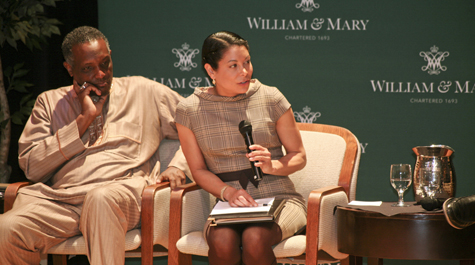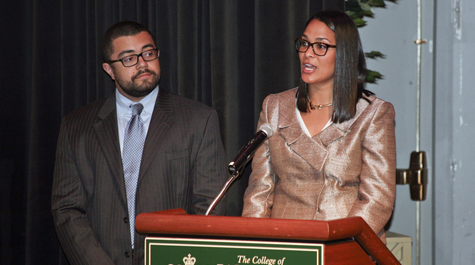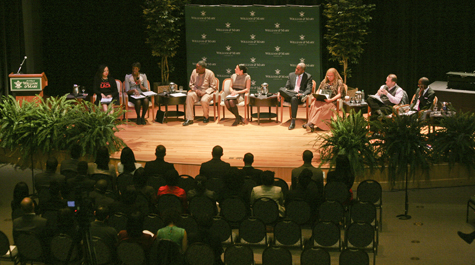BLSA Symposium on Race and the Law Brings Together Distinguished Panel for Town Hall Discussion
On March 17, 2015, William & Mary’s Black Law Students Association held its annual symposium on race and the law. The theme this year was “Where Do We Go From Here: Community or Chaos? A Conversation on Race, Law, and Current Events.”
The panel-style town hall event, held in the Sadler Center’s Commonwealth Auditorium, featured notable scholars, lawyers, and activists, and was co-sponsored by William & Mary’s Center for Student Diversity, the Office of Diversity and Equal Opportunity, the William & Mary Student Assembly, and The Lemon Project.
Students, administrators, faculty members, prominent alumni, and members of the community listened and participated in the exchange among panelists. Topics included policing and prison policies, affirmative action and higher education, the role of social media in fostering discussion and activism, and the potential for empirical data to help expose and correct racial bias in society.
The symposium’s distinguished panelists included Adrien K. Wing of the University of Iowa College of Law, Gregory Carr of Howard University, Eddie R. Cole of William & Mary’s School of Education, andré douglas pond cummings of Indiana Tech Law School, Monique L. Dixon of the NAACP Legal Defense Fund, and Jessica Pierce of Black Youth Project 100. Vivian E. Hamilton of William & Mary Law School and Jamel K. Donnor of William & Mary’s School of Education co-moderated the panel discussion.
Prior to the town hall symposium, Donnor delivered introductory remarks about Dr. Martin Luther King’s 1967 book Where Do We Go From Here: Chaos or Community?, which inspired the symposium’s theme. Donnor also discussed the contemporary relevance of the questions Dr. King posed nearly 50 years ago in his final published work.
Prior to Donnor’s remarks, Law School Dean Davison M. Douglas welcomed guests to the event and introduced the distinguished panelists after a warm introduction and tribute from law students Claire Wheeler, J.D. ’15 and Darren Ziegler, J.D. ’16.
A common theme in many of the topics discussed was the implicit and explicit influence of sociopolitical institutions on racial disparities, disadvantages, and biases. During the panel’s discussion of racialized microagressions, which Hamilton defined as “casual, sometimes unintended degradation of any socially marginalized group,” Carr gave examples of how these subtle and implicit instances of racial bias lead to harsh forms of structural disadvantages, barriers, and often violence against Blacks.
Professor cummings recalled instances of police discrimination he regularly witnessed during his childhood and adolescent years in the Southern Los Angeles area, and added that operational profit-driven policing and prison policies drive a biased societal criminalization of racial minorities.
Cole suggested that microagressions can also be found in the ways institutions restrictively recognize or ignore certain achievement, particularly in educational institutions, adding that this further contributes to systemic structural disadvantages for racial minorities.
Wing argued that some microagressions are not isolated events, but are symptoms of larger, systemic problems that lead to "spirit injuries"—a combination of long-term physical, emotional, and spiritual harms.
“Law can give us some of the treatments for these microagressions,” Wing said, but microaggressions can be properly addressed only through reforming large-scale institutional bias.
Pierce added that racial microagressions are even present in deflective forms of counter-messaging to contemporary social justice movements such as Black Lives Matter, and noted that it is important for racial minorities to persistently define and articulate their own lived experiences.
Dixon noted that racial biases and stereotypes in America’s classrooms have contributed to the boom in the school-to-prison pipeline.
Although the discussion highlighted social and institutional ills and challenges, the panelists expressed optimism in their answers to the question “Where Do We Go From Here?” The panelists charged students to have faith in achieving progress, to believe in their ability to make a difference, and to be aware of their own power.
Students were also encouraged to be active in their communities, serving either as public officials or through charitable work, and to influence the next generation by taking an active role in educating young people and mentoring those who follow in their respective professions or fields.
Panelists and audience members alike agreed the town hall symposium provided the opportunity for deep discussion and the motivation to continue the conversations in class, at work, and in the world.
About William & Mary Law School
Thomas Jefferson founded William & Mary Law School in 1779 to train leaders for the new nation. Now in its third century, America's oldest law school continues its historic mission of educating citizen lawyers who are prepared both to lead and to serve.





